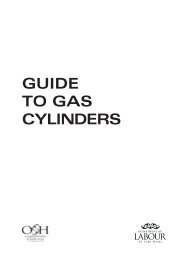Underground Petroleum Storage Tanks and Related Wastes - Code ...
Underground Petroleum Storage Tanks and Related Wastes - Code ...
Underground Petroleum Storage Tanks and Related Wastes - Code ...
You also want an ePaper? Increase the reach of your titles
YUMPU automatically turns print PDFs into web optimized ePapers that Google loves.
7.2 Permits, Regulations <strong>and</strong> St<strong>and</strong>ards<br />
The contractor shall responsible for obtaining all statutory permits unless stated<br />
otherwise in the principal’s contract documents. (See section 8.)<br />
The work shall be carried out in accordance with all applicable statutory<br />
regulations, whether those regulations require a permit to be issued or not.<br />
7.3 Safety of Contractor’s Personnel<br />
The works shall be carried out in accordance with all applicable occupational<br />
safety <strong>and</strong> health regulations, including those regarding work in excavations.<br />
The contractor <strong>and</strong> the project engineer shall both make themselves familiar with<br />
the regulations, particularly as they impact upon the execution of the contract for<br />
site works.<br />
7.4 Excavation Safety<br />
In general, every effort should be made to obviate the need for persons to enter the<br />
tank excavation. Where this is avoidable, regulations shall be complied with, <strong>and</strong><br />
particular care taken to eliminate any risks such as asphyxiation, presence of<br />
hydrocarbon vapours, or cave-in. No one shall ever enter an unshored or<br />
unbattered excavation unless the excavation has been certified to be stable by a<br />
competent person.<br />
7.5 Safety of Third Parties<br />
The contractor shall take all necessary precautions to ensure that the works are<br />
carried out in such a manner as to present no hazard to the site, customers, staff or<br />
the public in general.<br />
The project engineer shall satisfy himself, on behalf of the principal, that all<br />
reasonable measures have been taken. This duty upon the project engineer shall in<br />
no way relieve the contractor from his responsibilities in this area.<br />
Tank removal work may be undertaken as a separate contract with the<br />
principal. All excavations <strong>and</strong> work areas shall be barricaded, <strong>and</strong> authorised<br />
persons kept clear of such areas. Where work areas are open to the public or staff<br />
working on the site at night, the contractor shall provide <strong>and</strong> maintain adequate<br />
lighting to keep the area safe.<br />
Particular care must be taken on sites that continue in operation whilst work<br />
associated with lifting <strong>and</strong> transportation of tanks is being carried out. Equipment<br />
<strong>and</strong> materials to be used on-site shall be organised in such a manner as to cause no<br />
hazard to persons on or near the site.<br />
Notwithst<strong>and</strong>ing the above, both the tank transportation/disposal contractor <strong>and</strong><br />
principal should maintain appropriate insurance cover for any damage or injury to<br />
persons or property during the course of the works. (See Section 14.)<br />
7.6 Safe H<strong>and</strong>ling of <strong>Petroleum</strong> Products<br />
Brief notes of general safety precautions are contained in appendix 7.<br />
7.7 Electrical Equipment<br />
Any electrical equipment can be a possible source of ignition. Where any petroleum<br />
products vapours or related wastes may be present, the location of these<br />
hazards must be considered <strong>and</strong> hazardous areas identified. The requirements<br />
Transport <strong>and</strong> Disposal of <strong>Petroleum</strong> <strong>Storage</strong> <strong>Tanks</strong> 9





